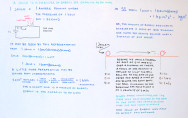Force, Energy, Work - Basic Conversions
Force
In all cases, Force has the property of imparting acceleration to particles or objects. If an object is anchored so it cannot move, a force against it produces pressure. The standard unit is the Newton, symbolized by N.Newton
The Newton is the Standard International (SI) unit of force. In physics and engineering documentation, the term Newton(s) is usually abbreviated N. One Newton is the force required to cause a mass of one Kilogram to accelerate at a rate of one Meter per Second squared in the absence of other force-producing effects.Newton = (Meter)(Kilogram)(Second)-2
Dyne
The Dyne (dyn) is the Centimeter-Gram-Second (cgs) unit of Force. This unit is rarely used these days in the United States, but it is commonly found in older physics and engineering literature. Although still preferred by some scientists, its use is actively discouraged in some industries in favor of the Newton (N), the unit of Force that is part of the International System of Units (SI). One Dyne is the Force required to cause a mass of one Gram to accelerate at a rate of one Centimeter per Second squared in the absence of other force-producing effects. To convert Dynes to Newtons, multiply by 0.00001 (10-5). To convert Newtons to Dynes, multiply by 100,000 (105).Dyne = (Centimeter)(Gram)(Second)-2
Energy
Energy is the capacity of a physical system to do work. The common symbol for Energy is the uppercase letter E. The standard unit is the Joule, symbolized by J. Energy is computed by multiplying the amount of Power by the time the Power is used. Energy is measured in Joules.Joule
The Joule is the standard unit of Energy in electronics and general scientific applications.This illustration goes into additional detail to help visualize what a joule is and how to describe it.

One Joule is defined as the amount of Energy exerted when a force of one Newton is applied over a displacement of one Meter. One Joule is the equivalent of one Watt of Power radiated or dissipated for one Second. In some applications, the British thermal unit (Btu) is used to express energy. One Btu is equivalent to approximately 1055 joules. A Joule reduces to one Kilogram-Meter squared per Second squared in base International System of Units (SI) units.
Joule = (Kilogram)(Meter)2(Second)-2
Joule = (Watt)(Second)
One Joule equals one Ampere flowing for one Second under the pressure of one Volt
Joule = (Volt)(Ampere)(Second)
Joule = (Newton)(Meter)
Joule = (BTU)(1055.060068)-1
Erg
The Erg is a small unit of Energy, equivalent to 0.0000001 (one ten-millionth) of a Joule. To convert from Joules to Ergs, multiply by 107. Conversely, multiply by 10-7. One Erg is the amount of energy equivalent to that expended by a force of one Dyne acting over a distance of one centimeter. One Erg reduces to one Gram-Centimeter squared per Second squared in base SI units.Erg = (Gram)(Centimeter)2(Second)-2